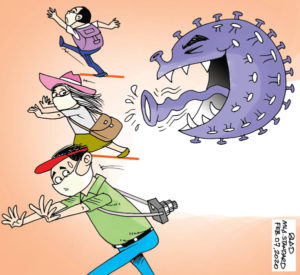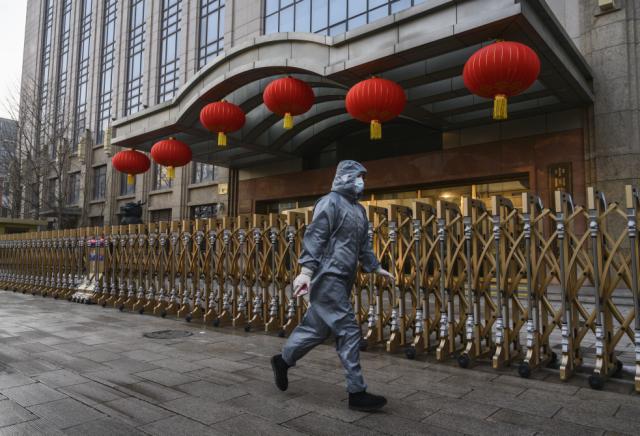NOVEL CORONAVIRUS ARD UPDATES: NEW YORK, USA- New Report on 138 Coronavirus Cases Reveals Disturbing Details

One patient, admitted to a hospital in Wuhan, China, infected at least 10 health care workers and four other patients with the coronavirus that has sickened more than 34,000 people, killed over 720 and reached two dozen other countries.
The case was just one disturbing detail in a new report on 138 patients in Wuhan that helps explain how the illness progresses and how it spreads.
The report, one of two published on Friday by JAMA, is among the most comprehensive articles to date about people infected with the newly identified virus.
.
ADS by:
Memento Maxima Digital Marketing

– SPACE RESERVE FOR YOUR ADVERTISEMENT –

The patients ranged in age from 22 to 92, with a median of 56 years, and were admitted to Zhongnan Hospital of Wuhan University from Jan. 1 to Jan 28. Many of them — 41% — were presumed to have caught the virus in the hospital, including 17 people who had been admitted for other illnesses, and 40 health care workers.
The patient who infected so many health workers had been placed in a surgical ward because of abdominal symptoms, and the coronavirus was not initially suspected. Four other patients in that ward also contracted the disease, presumably from the first patient.
The incident was a chilling reminder of the “super-spreaders” in outbreaks of other coronavirus diseases, SARS and MERS — patients who infected huge numbers of other people, sometimes dozens. The phenomenon is poorly understood and unpredictable, an epidemiologist’s nightmare. Super-spreaders led to considerable transmission of MERS and SARS inside hospitals.
.
ADS by:
Memento Maxima Digital Marketing

– SPACE RESERVE FOR YOUR ADVERTISEMENT –

Reporting on Friday in JAMA, the authors said their data suggested that rapid person-to-person spread of the virus had occurred among their cases. That was in part because of patients like the one admitted to the surgical department, whose symptoms misled doctors into suspecting other illnesses and failing to take precautions to prevent spread of the virus until it was too late.
About 10% of the patients did not initially have the usual symptoms, cough and fever, but instead had diarrhea and nausea first. Other uncommon symptoms included headache, dizziness and abdominal pain.
Another cause for concern was that some patients who at first appeared mildly or moderately ill then took a turn for the worse several days or even a week into their illness. The median time from their first symptoms to when they became short of breath was five days; to hospitalization, seven days; and to severe breathing trouble, eight days. Experts say that pattern means patients must be carefully monitored, and it is not safe to assume that someone who seems to be doing well early on is out of the woods.
The finding is a “heads up” to doctors to keep an eye on these patients, Dr. Anthony Fauci, director of the National Institute of Allergy and Infectious Diseases, said in a recorded interview posted by JAMA.
.
ADS by:
Memento Maxima Digital Marketing

– SPACE RESERVE FOR YOUR ADVERTISEMENT –

Like previous reports on coronavirus patients, this one found that older people and those with underlying health problems like diabetes, heart disease or cancer tended to become more severely ill than younger, healthier patients.
Overall, about 26% of the 138 patients needed intensive care; their median age was 66, compared with a median of 51 years for those who did not require intensive care.
For this series of patients, the death rate was 4.3%, which is higher than the estimates coming from other parts of China. The reason is not known, and the figures may change as more information is gathered.
Unlike some earlier reports, the new one did not find many more men than women to be infected: 54% of the patients were male.
The data on the patients shows that the illness caused pneumonia and a systemic viral infection that set off a powerful inflammatory response in the body, Dr. William Schaffner, an infectious disease expert at Vanderbilt University, said in an interview.
“There are biochemical indicators that a number of the body’s organ systems are likely affected and you have an inflammatory response that is disrupting their function to some extent,” Schaffner said.
.
ADS by:
Memento Maxima Digital Marketing

– SPACE RESERVE FOR YOUR ADVERTISEMENT –

The lungs, heart, liver, kidneys and the systems that control blood clotting are all affected, Schaffner said, though it is not clear that the virus itself infects organs other than the lungs.
The inflammatory response is a hallmark of a serious viral disease, he said, adding that in recent years it has become apparent that heightened inflammation from diseases like the flu can persist for a month or so after the acute illness is gone, and can increase the risk of heart attacks and strokes in older people.
The second JAMA report concerns 13 patients treated in three hospitals in Beijing from Jan. 16 to Jan. 29. They were younger than the Wuhan group, with a median age of 34, and no underlying diseases. Only one was over 50. The youngest was a 2-year-old. They did not become as ill as the Wuhan patients, and none died.
The cases, mostly in healthy, young adults, should dispel the notion that only older people contract the illness.
“It can take a young, healthy person and make them sick,” Schaffner said. “That’s clear from the health care workers and the young people in this paper.”
/ 
This article originally appeared in The New York Times.
© 2020 The New York Times Company
.
ADS by:
Memento Maxima Digital Marketing

– SPACE RESERVE FOR YOUR ADVERTISEMENT –


All photographs, news, editorials, opinions, information, data, others have been taken from the Internet ..aseanews.net | [email protected] | Fo r comments, Email to : Al Bulario









